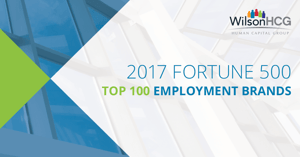Dissecting The 2017 Fortune 500 Top 100 Employment Brands Report
February 7, 2017The annual Fortune 500 Top 100 Employment Brands report was released this week – the third report of its kind. This report assesses employer branding strategies for each of the Fortune 500 companies against thirty benchmarks, which are grouped into six categories: career pages, job boards, employee reviews and candidate engagement, accolades, recruitment marketing, and corporate social responsibility. Employment branding demonstrates how a company is perceived as an employer. Why is this important? Well, because a company’s reputation is critical to attracting and retaining talent. This year’s top three companies, Johnson & Johnson, General Electric, and AT&T, share one common theme, their employer brands are transparent, consistent, and engaging. Read on as I break down the six categories of the report and dive into why each is crucial for successful employer brand.
Job boards
Job boards are springboards to a company’s employer brand. When seeking employment, candidates use job boards to search for opportunities then continue to the organization’s career page where they learn what it is like to work for the company. Companies, like the report's top three, understand that posting branded advertisements on mainstream job boards expand one’s audience and reputation. Job boards are often the first place candidates engage with an employer brand, so it’s critical these pages are updated and transparent
Career pages
Career pages are a place candidates visit to learn about the organization and ideally, learn enough about the company that they take the time to apply for a job. The top three companies’ career pages are transparent. They employ an engaging format while sharing information on the company’s benefits, perks, and culture. They invite prospective employees to be a part of their mission and even outline the recruitment process. This transparency allows an audience to experience a company’s employer brand and what it is like to be an employee.
Employee review and candidate engagement
Living an employer brand is imperative and reflected in an organization’s online reviews and ratings. It isn’t enough to only talk about an employer brand on a career page. Candidates seek consistency between what a company says and how it acts. In job searches, candidates visit websites like Glassdoor.com to read current and past employees’ reviews and ratings. The top three F500 companies earned high points in this category as their reviews and ratings echo the perception detailed on their career pages.
Accolades
Awards are important because they validate a company’s initiatives and achievements. This affirmation proves to prospective candidates that a third party recognizes the organization as a leader, making this a necessary component of assessing an employer brand. The leaders in this year’s report demonstrated consistency in their employer brand by earning accolades. Additionally, they stayed true to their transparent theme by publishing this information on their company websites.
Recruitment marketing
Recruiting is relationship-centric, and with the evolution of technology and social media perspective, employees expect companies to interact at a deeper level. An online presence goes both ways. Recruiters use social media to seek and attract talent, but the reverse is also true. Prospective employees not only search company websites and career pages, but they expect organizations to engage online. The report’s top three companies led these efforts by employing corporate and career specific social media accounts, blogs, and talent communities. By using these platforms to share pictures and videos of real employees, these companies project genuine messaging on what it is like to work for the company.
Corporate social responsibility
No longer are the days where people look at employers as simply a paycheck. Rather, candidates want to feel the company they work for is a part of a bigger mission. That is why corporate social responsibility is part of an employer brand. How an organization views diversity and contributes to its community and environment are critical to the company’s reputation. Employers, like Johnson & Johnson, General Electric, and AT&T, highlight corporate social responsibility efforts on their websites and career pages.
As the concept of an employer brand expands, WilsonHCG’s Research Institute® evolves the grading methodology used to assess the Fortune 500 companies. This year, the methodology awarded points to organizations that outlined their interview process and hiring criteria, and those who were consecutively named to the CandE Awards. The corporate social responsibility category moved away from being list-based and in place measured a company’s efforts by what is published on its website. From job boards to social responsibility, this year’s top three companies excel in all categories because they are committed to transparent, consistent and engaging employer brands.
About WilsonHCG
WilsonHCG is an award-winning, global leader in total talent solutions. Operating as a strategic partner, it helps some of the world’s most admired brands build comprehensive talent functions. With a global presence spanning more than 65 countries and six continents, WilsonHCG provides a full suite of configurable talent services including recruitment process outsourcing (RPO), executive search, contingent workforce solutions, talent consulting and talent intelligence.



![[REPORT] Get Your Copy Of The 2017 Fortune 500 Top 100 Employment Brands Report!](https://no-cache.hubspot.com/cta/default/441864/a501d64c-48a1-4b52-8cfe-d65f392c7869.png)
